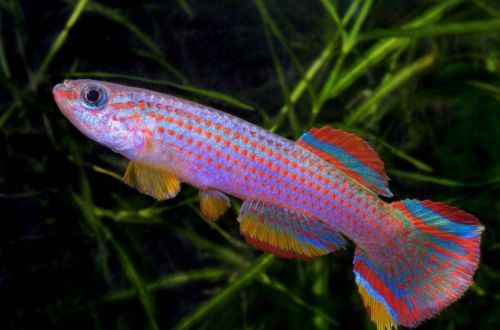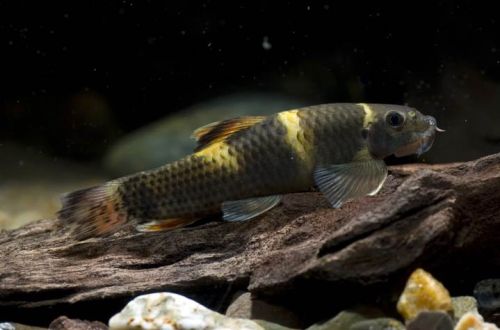
Ruby Tetra
Ruby Tetra or Axelrod Rice, scientific name Axelrodia riesei, belongs to the Characins (Characin) family. One of the species’ names is a composite of the names of two scientists, Herbert R. Axelrod and William Rees. It is considered quite demanding on the conditions of detention, which limits its popularity in amateur aquariums.

Contents
Habitat
Comes from South America from the basin of the Meta River (Colombia) – the left tributary of the Orinoco. Inhabits small streams and rivers, less often the main channels of rivers flowing under the canopy of dense tropical forest. The natural habitat is a canal in the shade of trees, the bottom of which is littered with fallen leaves and snags in the form of roots and branches. The water is saturated with tannins from decaying plant organics, giving it a brown color.
Brief information:
- The volume of the aquarium – from 40 liters.
- Temperature – 20-28°C
- Value pH — 4.0–6.5
- Water hardness – 1–5 dGH
- Substrate type – sandy
- Lighting – subdued
- Brackish water – no
- Water movement is weak
- The size of the fish is about 2 cm.
- Food – any food
- Temperament – peaceful
- Keeping in a group of 8-10 individuals
Description
Adult individuals reach a length of about 2 cm. Sexual dimorphism is weakly expressed, males and females practically do not differ from each other outwardly. Outwardly, it resembles its close relative Tetra-Pepper, only differs from it in color, having a bright orange color. Fins are translucent. There is a black and white mark at the base of the tail.
Food
Omnivorous species, accepts most suitable sized foods intended for aquarium fish. The daily diet may consist exclusively of dry foods in the form of flakes, granules. If possible, it is worth diversifying the diet with live or frozen brine shrimp, daphnia, bloodworm pieces, etc.
It is worth remembering that poor-quality feed leads to fading of color, and in some cases to its complete loss.
Maintenance and care, arrangement of the aquarium
The optimal size of the aquarium for a group of 8-10 fish starts from 40 liters. The design is arbitrary with dim lighting, preferably the use of natural elements: sandy soil, driftwood, aquatic shade-loving plants, etc.
An important, but not obligatory element of decor is the dried leaves of some trees, which are placed at the bottom. With their gradual decomposition, processes similar to those that occur in natural reservoirs occur – tannins are released, and the water acquires a characteristic brown tint. In addition, the leaves can provide a valuable secondary food source for fry by developing a beneficial microbial colony from shoe ciliates.
Successful rearing of Ruby Tetra is possible in acidic water with low carbonate hardness. To achieve favorable conditions, it may be necessary to install a filtration system with filter material that acidifies the water, as well as use reverse osmosis to reduce hardness. The fish is sensitive to the accumulation of organic waste, so procedures for weekly replacement of part of the water with fresh and timely removal of food residues, excrement, etc. are mandatory.
Behavior and Compatibility
They are peacefully disposed towards other species, which is not surprising due to their modest size. Compatible with non-aggressive fish of comparable size. They are not characterized by a flocking lifestyle, males occupy plots and compete with other females for territory and females. Rivalry is harmless and does not lead to injury. However, it is recommended to maintain a group of at least 8-10 individuals.
Breeding / breeding
Reproduction of Ruby Tetras is achieved in the artificial environment of aquariums under favorable conditions and a balanced diet. Fish are able to give birth throughout the year, seasonality is not expressed, therefore, in a large group, fry can appear almost every week.
The fish do not show parental care and, on occasion, will certainly eat their own caviar. In order to preserve the brood, fertilized eggs are transferred to a separate tank with identical water conditions.
The hatched fry are very small and require microscopic food, such as the ciliates mentioned above or specialized liquid or powder products.
Fish diseases
Diseases inherent in this particular species of fish were not noted. When kept in suitable conditions (high water quality, balanced diet, non-conflict neighbors, etc.), health problems are not observed. The most common cause of disease is the deterioration of conditions leading to immune suppression, which makes the fish susceptible to infections that are invariably present in the surrounding area. When the first signs of an illness are detected (lethargy, exhaustion, refusal of food, lowered fins, etc.), it is necessary to immediately check the main parameters of the water. Often, the restoration of acceptable living conditions contributes to self-healing, but if the fish is too weak or has received obvious damage, medical treatment will be required. For more information on symptoms and treatments, see the Aquarium Fish Diseases section.





